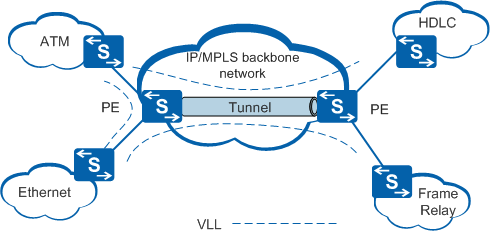Overview of VLL
Definition
Virtual leased line (VLL) technology, also called Virtual Private Wire Service (VPWS), emulates leased lines on an IP network to provide a low-cost asymmetrical digital data network (DDN) service. It is a point-to-point (P2P) Layer 2 tunneling technology, based on Multiprotocol Label Switching (MPLS), which allows the exchange of data packets between networks using different media. Figure 1 shows an example of VLL networking.
Purpose
- There are many different types of Layer 2 networks: Ethernet, Asynchronous Transfer Mode (ATM), Frame Relay (FR), and High-Level Data Link Control (HDLC). However, because they use different protocols, they are isolated from one another.
- More Ethernet connections are required between large cities and remote areas. Traditionally, service providers use direct-leased lines or set up Layer 2 tunnels between two areas, but this is expensive and can be difficult to maintain and extend.
Service providers need a solution to these problems. VLL technology establishes a compatible Layer 2 switching network that is cost effective and is easy to maintain and extend. Based on MPLS technology, VLL allows multiple customers to share one leased line and creates an exclusive virtual channel for each customer on the shared line. On an Ethernet network, sites in different cities can communicate over a P2P VLL connection on an MPLS network, just like communicating within a virtual local area network (VLAN).
Since Ethernet has replaced most other Layer 2 networks, VLL is rarely used for communication between different networks, but is widely used for Layer 2 transparent transmission.
VLL is an MPLS-based Layer 2 virtual private network (L2VPN) technology to directly transmit Layer 2 data. VLL establishes P2P VPN tunnels for P2P communication. However, P2P service eventually became insufficient to meet user requirements, and in response a point-to-multipoint (P2MP) technology, called Virtual Private LAN Service (VPLS) was developed. For details about VPLS, see VPLS Configuration.
Benefits
Extended network functions and service capabilities for carriers
Carriers can use VLL and enhanced MPLS technologies, such as traffic engineering (TE) and quality of service (QoS), to provide users with differentiated services, meeting user's individual needs.
Interconnection between networks using different Layer 2 protocols
VLL allows an Internet service provider (ISP) network to provide connections and switching services using multiple Layer 2 protocols.
Higher scalability
VLL uses label stacks to identify multiple virtual circuits (VCs) in one label switched path (LSP). Therefore, the provider (P) device only needs to maintain information about one LSP, improving system scalability.
Smaller maintenance workload
VLL establishes VPNs in large-scale enterprises with large sites and many routes. P devices on the ISP networks only need to forward packets over tunnels on the public network according to MPLS labels and do not need to maintain any Layer 2 information.
Smooth network upgrade
VLL is transparent to users, so carriers can smoothly upgrade their traditional L2VPN networks to MPLS L2VPN networks, without affecting configurations on customer networks. The network upgrade does not affect user services, except for a brief period of data loss during network migration.
